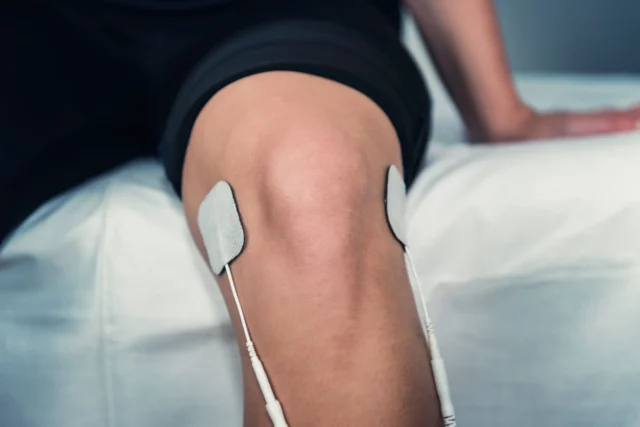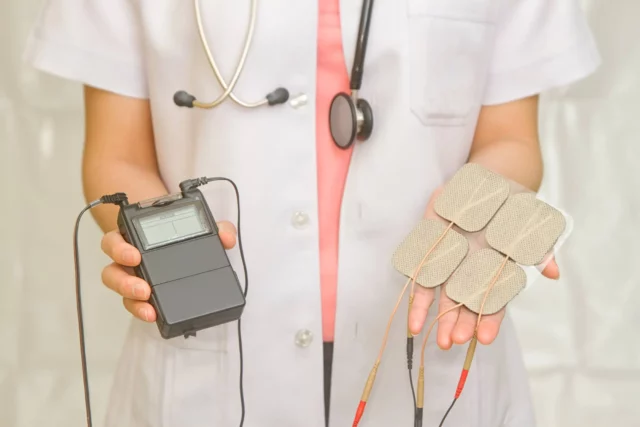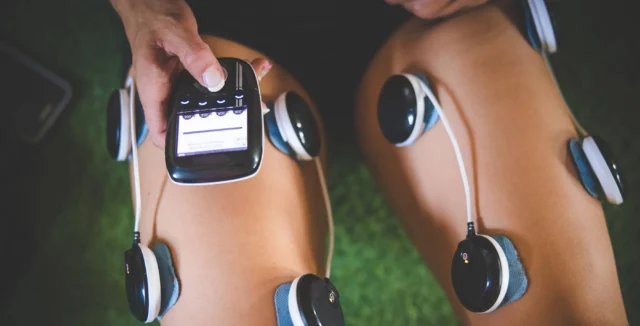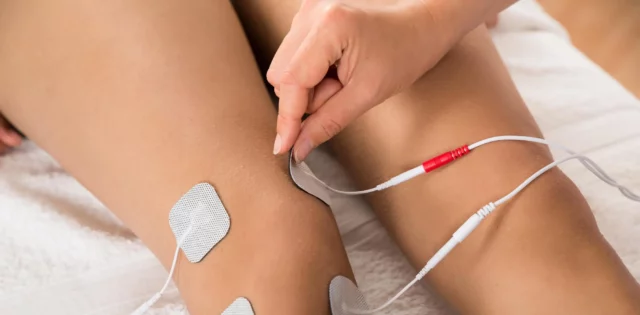Chronic knee pain affects over 25% of the population, making it one of the most widespread musculoskeletal disorders worldwide. Given how much we rely on our knees for everyday activities, it is easy to estimate the extent of the impact that this condition may have on a person’s life. From dealing with recurring pain and reduced mobility to facing the challenges associated with care costs and declining productivity, chronic knee pain can be debilitating.
However, approaches such as electrical stimulation therapy are now offering a non-pharmaceutical and non-invasive alternative to treat knee pain. Let’s look at how these therapies work and their effectiveness below.
Electrical Stimulation For Knee Pain
Electrical stimulation, also known as neuromodulation or e-stim, is a pain management approach that uses electricity to decrease knee pain and discomfort. During the treatment, mild pulses of electrical current are delivered to the area affected by pain with the use of adhesive pads.
The pulses of electricity produce several effects, including:
- Stimulating blood flow: The electrical pulses promote the flow of blood, nutrients, and oxygen to the injured area, supporting the body’s ability to heal and regenerate damaged tissue. This can also reduce inflammation, easing swelling, redness, and stiffness.
- Triggering the release of endorphins: Similar to massage therapy, electrical stimulation can trigger the release of chemicals known as endorphins, which are the body’s natural painkillers.
- Modulating how your brain processes pain: The electrical pulses act by “flooding” the nervous system and preventing pain signals from reaching the brain. The current may also trigger a shift of electrical charge in pain neurons in the brain, known as depolarization, which can reset your perception of pain and lead to long-lasting relief.
- Helping muscles contract properly: E-stim can stimulate muscle movements, which can help prevent muscle shrinking (atrophy). Loss of muscle mass can be a complication of disability and prolonged immobilization, contributing to further damage to the knee components.
This approach can be used by a large percentage of the population because it poses minimal risks.
With the guidance of a specialized healthcare professional, electrical stimulation can be used to address a wide range of conditions that cause knee pain. The most common ones include:
- Excessive stress
- Direct trauma
- Fractures or dislocations
- Torn tendons or ligaments (i.e.: sprains or strains)
- Inflammatory conditions (i.e.: tendonitis and bursitis)
- Arthritis and osteoarthritis
With over 303 million cases worldwide, osteoarthritis is the leading cause of knee pain among older adults. This degenerative condition causes the breakdown of the joint’s components, leading to pain, reduced mobility, and, in severe cases, disability. Other factors that increase your risk of suffering from knee pain later in life include obesity, a sedentary lifestyle, and overuse.
Given the permanent or degenerative nature of most conditions affecting the knee, electrical stimulation therapy represents a more sustainable pain management approach compared to pharmaceuticals or surgery.
Different Types Of Electrical Stimulation Therapy
Electrical stimulation therapies are often used as part of a more comprehensive physical therapy and pain management program, usually in combination with other therapies. Below, we’ll look at the different types of E-stim therapies and when they should be used to treat knee pain.
Transcutaneous Electrical Nerve Stimulation (TENS)
Transcutaneous electrical nerve stimulation (TENS) is one of the most popular types of neuromodulation therapy. TENS units are today available as over-the-counter devices and allow for the self-administration of the treatment.
Using TENS units for knee pain may provide relief by interrupting or altering the pain signals traveling from damaged tissues in the knee joint to the brain.
How Does It Work?
TENS is performed using a portable, battery-operated device attached to a set of electrodes (adhesive pads) that are placed around the knee joint. Selecting the right setting, the device sends mild pulses of electricity through the skin and the joint components.
The surge of electrical activity in the area pauses pain signals from reaching the brain and spinal cord, where they are processed. This action, coupled with the release of endorphins and a reduction of inflammation, can ease painful sensations.
Depending on your TENS device, you may be able to choose one of many settings and adjust the rate at which the pulses are delivered (frequency). This kind of E-stim therapy is the most commonly used to address both acute (short-term) and chronic (long-term) knee pain.
Case Studies On Effectivity
Studies conducted in 2000 show that TENS can be used in the management and modulation of knee pain deriving from osteoarthritis. In a review published in 2015 by Cochrane, using transcutaneous electrical nerve stimulation reduced pain intensity by 50% in half of the patients studied.
However, not all studies have reached the same conclusions. According to a randomized controlled trial published in 2015, TENS improved subjective measures, such as pain intensity, functional abilities, and quality of life. However, a clinical trial published in 2021 in the Osteoarthritis and Cartilage Journal shows that TENS may not improve osteoarthritis pain.
Neuromuscular Electrostimulation (NMES)
Neuromuscular electrical stimulation (NMES) is a procedure used to deliver mild pulses of electrical current to weak or paralyzed muscles. The electrical pulses help the muscles contract properly, which improves muscle strength, promotes blood circulation, and relieves muscle spasms.
How Does It Work?
NMES works similarly to TENS units. Electrodes attached to a battery-operated device are applied to the areas around the knee. Mild pulses of electrical current are then delivered to the muscles that support the knee joint to re-educate the muscles to contract properly.
During an NMES therapy session, the electrodes are attached to the knee while you perform everyday tasks, such as walking. As your leg moves, the electrical stimulation turns on, instructing the muscles to contract when they are supposed to contract. Vice-versa, the stimulation turns off when your muscles are supposed to relax or rest.
This form of therapy may help people regain their knee function after surgery (i.e.: total knee arthroplasty) or a long period of immobilization following an injury. NMES may also be used in people with arthritis to strengthen the muscles surrounding a weakened knee joint or to prevent a loss of muscle mass that may occur due to disuse.
Case Studies On Effectivity
Studies show promising results that NMES can help patients regain their muscle function. According to a 2019 study published by Frontiers, re-educating muscles to contract properly can play a role in the management and prevention of chronic conditions, especially in individuals who are unable to practice physical exercise. The same study suggests NMES can prevent muscle atrophy in patients with reduced mobility, help maintain muscle strength, and support recovery from invasive surgeries such as total knee arthroplasty. A 2012 study also shows that undergoing NMES therapy for 8 weeks helps patients with knee osteoarthritis improve their quadriceps strength and overall health.
Interferential Current Therapy (ICT)
Interferential Current Therapy (ICT) is a type of electrical stimulation therapy used to modulate pain and improve blood circulation to damaged tissues. This double action ensures that the pulses can reach deeper into the tissue and inhibit the transmission of pain signals to the brain. ICT may also be more effective in boosting blood circulation and triggering the release of pain-relieving hormones like endorphins.
How Does It Work?
Although ICT is similar to TENS in many ways, this kind of therapy differs because it delivers two pulses of electricity at two different medium frequencies. The pulses alternate throughout a single session and can be adjusted and varied to address different types of painful tissues.
During an ICT session, one of the pulses is kept at a constant frequency (usually 2000 Hz, 4000 Hz, or 6000 Hz), while the other one varies within a range of frequencies. This prevents your body from becoming used to the current and improves this therapy’s efficiency.
ICT is often recommended to patients with knee osteoarthritis because of the longer-lasting pain-relieving action, but it can also be used in the treatment of sprains, strains, and joint damage.
Case Studies On Effectivity
A systematic review conducted in 2015 on the efficacy of various electrical stimulation therapies suggests that ICT is the most prominent pain management method for knee osteoarthritis. Additionally, a 2021 study on the analgesic effects of ICT shows that this therapy can efficiently relieve pain in people with knee osteoarthritis and post-operative knee pain. The same study highlights that the frequencies selected during the ICT therapy did not have an impact on its analgesic effects.
Electronic Muscle Stimulation (EMS)
Electronic Muscle Stimulation (EMS) is sometimes referred to as Russian stimulation. This therapy works similarly to Neuromuscular Electrical Stimulation and aims to re-educate the muscles to contract properly during movement. This aids the maintenance of muscle mass and prevents muscle atrophy in people with degenerative knee conditions, limited mobility, temporary or permanent immobilization, and disability.
How Does It Work?
EMS is similar to NMES: it delivers electrical current to the nerve endings within the muscles to trigger contractions. However, EMS uses intermittent and alternating medium-frequency electrical pulses (Russian Current), which help create more powerful or forceful movements in muscles that are otherwise unable to contract.
This therapy may be used to help strengthen the muscle mass around a weakened knee joint, which can happen due to osteoarthritis. Although EMS is sometimes used in physical therapy and weight loss programs, it is mainly recommended to relieve muscle spasms, prevent muscle loss, and retrain muscles to contract properly.
Case Studies On Effectivity
According to a 2019 study, EMS can be considered to be an affordable and efficient instrument to ease pain and speed up recovery following an athletic knee injury, such as a torn Anterior Cruciate Ligament (ACL) tear. The same study shows that EMS may be efficient in promoting the health and strength of the quadriceps muscle group after ACL repair surgery. A 2017 study conducted on rats also shows that the use of Russian stimulation can speed up the bone regeneration process.
Benefits Of Electrical Stimulation Therapy
According to the research and case studies seen above, electrical stimulation may have analgesic or pain-relieving effects in people suffering from a range of conditions causing knee pain. But the benefits of these therapies go beyond simply easing discomfort. Let’s look at these benefits below:
- Reduce chronic pain: By interrupting the pain signals traveling to the brain, E-stim therapy reduces painful sensations and discomfort in people with chronic conditions, such as osteoarthritis.
- Decrease inflammation and swelling: A study published in 2023 by The Feinstein Institutes for Medical Research shows that electrical stimulation may help relieve inflammation by stopping the release of inflammatory molecules in the brain. Additionally, by forcing the muscles to contract, E-stim combats the build-up of fluids and swelling that occurs when the muscles are still for too long (edema).
- Improve range of motion: E-stim therapies help reduce the swelling and stiffness caused by inflammation, which can help you move your knee joint more freely.
- Reduce muscle spasms: When used for muscle stimulation, electrical stimulation can modulate the activity of motor nerves within the muscles. This helps reduce involuntary movements such as spasms, fasciculations, and cramps, which are often caused by motor nerves misfiring spontaneously.
- Improve neuromuscular rehabilitation: E-stim therapies can be used to help patients build up or maintain muscle mass in the event of immobilization or reduced mobility. When used to retrain muscle contraction, E-stim can promote greater mobility, help reduce the risk of muscle atrophy, and support overall musculoskeletal health.
What To Expect During The E-Stim Therapy
What to expect during E-stim therapy depends on the type of device used and the results you are looking to achieve. Before your first session, your healthcare provider will guide you through each step of the therapy, aftercare, and expected results.
Below, you’ll find an overview of what happens during an electrical stimulation therapy session.
The Process
Normally, electrical stimulation therapy is used as part of a broader physical therapy or rehabilitation program that aims to restore knee function, support recovery from an injury, or reduce pain. In these cases, the therapy is administered by a professional using medical-grade devices. You’ll be instructed on how many sessions are needed to achieve the desired results and on the best type of E-stim for your needs. Below, we’ll look at what happens during and after the therapy.
Note: Some TENS units are also available as over-the-counter devices. Although these devices allow you to self-administer the treatment, they come with reduced electrical power. The limited strength and frequency of the electrical pulses may not be enough to improve your knee pain.
During The Therapy
Most electrical stimulation units are battery-powered devices attached to electrodes via thin wires. The electrodes are adhesive pads that are temporarily placed on the skin and can be easily removed at the end of the session.
During the therapy, mild pulses of electrical current are delivered to the area receiving treatment via the electrodes. With the supervision of a professional, the electrical current is adjusted to provide powerful but not painful stimulation.
Note: While E-stim may cause tingling and “pins and needles” sensations, it should not be painful. Tell your doctor immediately if you are experiencing pain.
Some electrical stimulation therapies, such as those used to address knee pain from arthritis and joint conditions, are passive, meaning that you will relax during treatment. Conversely, when E-stim is used to improve muscle mass, prevent muscle atrophy, or retrain your muscles to contract properly, you may need to engage in movements such as walking.
Let’s look at the E-stim therapy process in more detail below.
Application Of Electrodes
After determining the area of pain and its cause, your healthcare provider will start the therapy by placing the electrodes around the knee. Usually, two or four pads are placed in the area around the knee, on the front, back, and sides of the joint. The most common placement for the electrodes is illustrated below:
Your doctor will determine how many pads you need and where they should be placed. However, usually, the pads’ placement is determined by where you feel pain. A few rules include:
- Two pads are used if the pain is localized to a smaller area
- Four pads are applied if the pain radiates from the knee to the surrounding structures
- The kneecap should be avoided, but the electrodes can be placed around it
- Placing the pads at the front of the knee can help with joint problems such as arthritic pain
- Placing the pads on the side of the knee can support muscle contraction and re-education after injury or immobilization
- The pads can also be placed at the back of the knee if that’s where the source of pain is
If the therapy is administered within clinical settings, your healthcare provider will place the electrodes for you. If you decide to use an at-home TENS unit, you may follow your doctor’s instructions to correctly place the electrodes.
You should not place the electrodes on:
- Infected or irritated skin
- Skin that has recently been treated with radiation
- Open wounds
- Near the nose, eyes, or mouth
- Reproductive organs
- Areas of the body with inhibited sensation or numbness
The pads should be applied to clean and dry skin. They should not touch each other or any metal object, such as a belt buckle.
Gradual Increase Of Electrical Current
Once the electrodes are correctly placed around the knee, the electrical stimulation device is turned on at the lower setting. The electrical pulses are fine-tuned based on the following parameters:
- Frequency: The rate at which pulses of electricity are delivered, measured in hertz (Hz).
- Intensity: How intense the sensations caused by the electrical current are.
- Pulse Width: How long each pulse of electricity lasts, measured in microseconds (μs).
Low-intensity pulses will cause you to experience tingling and “pins and needles” sensations. These sensations are known as paresthesia and, while they may feel strong, they should be comfortable and not painful.
The therapy provider will gradually increase the intensity and frequency of the electrical pulses to cause sensations closer to your pain threshold. If the treatment is administered to build or maintain muscle mass, you may also experience mild muscle twitches and contractions.
How Long Is The Therapy?
Each electrical stimulation therapy can last between 5 and 15 minutes, depending on which condition you are aiming to treat and what type of therapy is used. At-home TENS units can be used for 30-60 minutes up to four times a day.
According to a 2003 study, the best results among people with osteoarthritic knee pain were achieved when electrical stimulation was used for 40 to 60 minutes, 5 days a week for 2 weeks.
Additionally, a 2019 study shows that NMES, when administered for 20 minutes 3 times a day for 6 weeks, can help patients regain knee function after total knee replacement surgery.
The effects of electrical stimulation can last between 5 minutes and 18 hours.
Post-Therapy Care
As a non-invasive therapy, electrical stimulation does not involve long periods of downtime or recovery. However, your doctor may recommend aftercare instructions that can improve the therapy’s results and prevent injuries.
Some guidelines include:
- Take care of the skin areas where the pads were applied, as they may be sensitive or irritated.
- Interrupt the treatment if your skin is not tolerating the electrodes well, or if you feel dizzy.
- After treatment, avoid strenuous activities. Instead, opt for light exercise and rest as needed.
- If you have been given a unit to use at home, clean the pads and safely store your unit.
Risks And Limitations Of Electrical Stimulation Therapy
When administered by a professional and following a health exam, electrical stimulation is considered to be safe. Although minor, some risks you may run when choosing this therapy include:
- Allergic reactions to the glue that makes the electrodes adhesive
- Skin irritation and contact dermatitis
- Momentary increase in painful sensations
- Tingling and “pins and needles” sensations
- Muscle fatigue and mild twitching (due to E-stim overuse)
- Decreased blood pressure
A study conducted in 2015 also shows that the chronic use of low-frequency electrical stimulation can contribute to the accumulation of waste materials in the muscle fibers, which can lead to muscle fatigue and damage.
At-home TENS units are considered safe because of the low strength of the electrical pulses they deliver. Nonetheless, you should apply the electrodes with care to avoid sensitive areas such as the genitals and abdomen. Electric stimulation devices should not be used when bathing or showering.
When You Should Avoid Using E-Stim
As seen above, electrical stimulation can be a valid pain management option for a range of knee conditions. However, just like any other treatment, this type of therapy isn’t equally suitable or safe for everyone.
In particular, E-stim is contraindicated for:
- Pregnant women, especially during the first trimester
- Patients wearing a medical implant or device, such as internal hearing aids or pacemakers
- Epileptic patients
- Patients with deep vein thrombosis (the increased blood circulation may increase the risk of blood clots)
- Patients with a history of cancer in the past five years
- Patients with actively bleeding tissue or a history of bleeding disorders
- Patients with heart disease
You should also avoid using electrical stimulation to address pain that has not been properly diagnosed.
Improve The Quality Of Your Life With The Right Treatment
Chronic or acute knee pain can inhibit activities that are part of a normal and fulfilling life, such as climbing stairs, enjoying walks outdoors, taking care of yourself, cooking, or moving around your home. But taking pharmaceuticals daily or undergoing a total knee arthroplasty are no longer the only options to manage your pain.
At NextPain Care, among the modalities we use in approaching chronic or acute knee pain, is mindfulness and meditation, which promotes relaxation and mental focus. By integrating these practices, NextPain Care enhances its holistic pain management approach, resulting in reduced pain perception and improved well-being for patients.
NextPain Care’s embrace of mindfulness and meditation underscores our dedication to holistic pain management. By integrating these methods, we assist patients in cultivating coping mechanisms that boost their mental and physical well-being, fostering a harmonious and pain-free living.
Ready to take the first step towards regaining your mobility?




